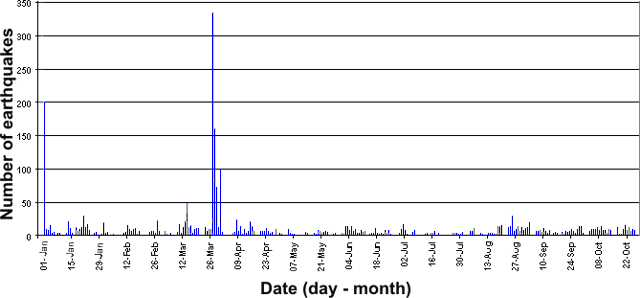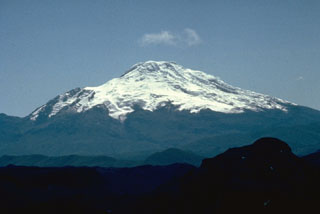Report on Cayambe (Ecuador) — November 2003
Bulletin of the Global Volcanism Network, vol. 28, no. 11 (November 2003)
Managing Editor: Edward Venzke.
Cayambe (Ecuador) Some anomalous 2003 seismicity
Please cite this report as:
Global Volcanism Program, 2003. Report on Cayambe (Ecuador) (Venzke, E., ed.). Bulletin of the Global Volcanism Network, 28:11. Smithsonian Institution. https://doi.org/10.5479/si.GVP.BGVN200311-352006
Cayambe
Ecuador
0.029°N, 77.986°W; summit elev. 5790 m
All times are local (unless otherwise noted)
This report largely discusses seismicity at Cayambe during January-October 2003 (figure 1). On the whole, the numbers of daily earthquakes remained fairly constant at low to moderate levels (typically fewer than 25 earthquakes per day). On six days the number of daily earthquakes approached 50 or greater (1 January, 15, 28, 29, and 30 March, and 1 April). Epicenters were concentrated on the SW flank, similar to the pattern in December 2002. During the year, residents did not report feeling earthquakes at Cayambe, but did notice sulfurous odors. Although some seismic signals had an uncertain origin, others were interpreted as related to magma movement.
 |
Figure 1. The total number of earthquakes each day at Cayambe between 1 January and 27 October 2003. Courtesy of the Instituto Geofisico-Escuela Politecnica Nacional, Ecuador. |
Observers saw no changes at Cayambe during January, although strong sulfurous odors were reported early in the month. Very low seismicity prevailed, with an average of five earthquakes per day during the second week in January. In general, the earthquakes registered since 2 January 2003 were long-period earthquakes; a few hybrid events and fracture events also were recorded. Some small volcano-tectonic (VT) earthquakes registered. On 31 January, following a week of low to moderate seismicity, two larger earthquakes were recorded: the first under the volcano, M 3.9; the second to the E, M 3.5. Neither earthquake was felt by area residents. Associated, small long-period (LP) earthquakes also registered, although the late-January daily totals were still low to modest. Following this activity, seismicity dropped and generally remained low through February and early March.
On 8 March an M 3.6 earthquake triggered about 2 hours of small VT earthquakes beneath Cayambe's S flanks. Seismicity again dropped to low levels until 14 March when there was a small cluster of shallow VT earthquakes lasting about 1 hour. These events were under M 2, and afterwards seismicity dropped to background levels.
The high for the year occurred during 24-30 March when earthquakes peaked at approximately 335 per day. Clusters of events were noted. Those on 27 March included an M 3.9 earthquake, and those on 29 March included two M 3.6 earthquakes. The events were located at 5-6 km depth below the SW flank. This was the same area in which seismic clusters occurred during December 2002. There were 99 earthquakes counted on 31 March. None larger than M 3, they consisted of up to 95 VT and four hybrid events.
In early April seismicity again dropped to low levels, increasing slightly in the second week of the month. The recorded LP and hybrid events registered were thought likely related to fluid movement inside cracks. Small VT earthquakes were recorded on 13 April; otherwise, seismicity remained low through the rest of the month. The smell of sulfur was noticed during a 14-20 April visit, but no other changes were noted. Seismicity remained low throughout May, with only occasional VT, LP, and hybrid events.
Seismicity increased slightly in early June, but still remained close to background levels. A new signal appeared at the Refugio station, characterized by high frequency at the beginning and a very long coda (tail). Thereafter, activity dropped and remained low for the rest of June.
A series of VT earthquakes occurred during the first week of July; the maximum activity was on 1 July, with 16 events. Nevertheless seismicity remained near background levels, and stayed low until early August. A VT earthquake occurred on 4 August beneath the W flank; on 6 August seismicity increased slightly and was characterized by hybrid events. Activity was low through mid-August. A series of VT events related to rock fracturing occurred between 18 and 31 August; the majority occurred on 22 and 25 August, with events reaching M 3.5. These events beneath the SW flank were similar to the spike in activity in March. Activity dropped again during the following month.
For the last week of September, seismicity was still at background levels. A single VT event registered, with a magnitude of 3.2, located beneath the volcano at a depth of 4 km. As with the previous cases, the event was too small to be felt by area residents. Between 13 and 19 October, seismicity generally remained normal, but on 15 October, a small cluster of VT earthquakes occurred S of the crater. On 23 October another small cluster of VT earthquakes (M <3) was recorded beneath the SE flank, in a part of the same zone as the events of the previous week.
Over these weeks the base seismicity level seemed to increase slightly (figure 1). During 3-9 November, about nine earthquakes occurred per day, near the daily average since August 2003 and about twice the daily average of 4/day before that. Seismicity also included small clusters of tectonic earthquakes with magnitudes less than 3. There were reports of a strong scent of sulfur in the vicinity of Picos Jarrína at an elevation of about 5,460 m. The scent was strongest near cracks.
Geological Summary. The massive compound andesitic-dacitic Cayambe stratovolcano is located on the western edge of the Cordillera Real, east of the Inter-Andean Valley. The volcano, whose southern flank is on the equator, is capped by extensive glaciers. The modern Nevado Cayambe, constructed to the east of older Pleistocene volcanic complexes, contains two summit lava domes about 1.5 km apart. Several other lava domes on the upper flanks have been the source of pyroclastic flows that reached the lower flanks. A prominent Holocene pyroclastic cone on the lower E flank, La Virgen, fed thick andesitic lava flows that traveled about 10 km E. Nevado Cayambe has also produced frequent explosive eruptions beginning about 4,000 years ago, with the most recent known activity during 1785-86.
Information Contacts: Geophysical Institute (IG), Escuela Politécnica Nacional, Apartado 17-01-2759, Quito, Ecuador (URL: http://www.igepn.edu.ec/).

